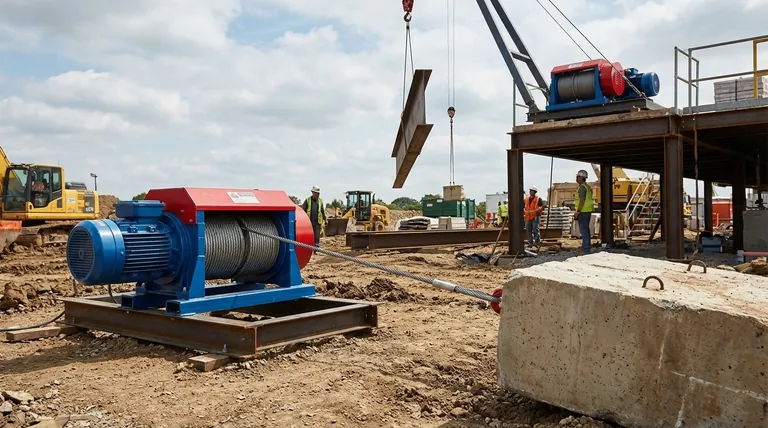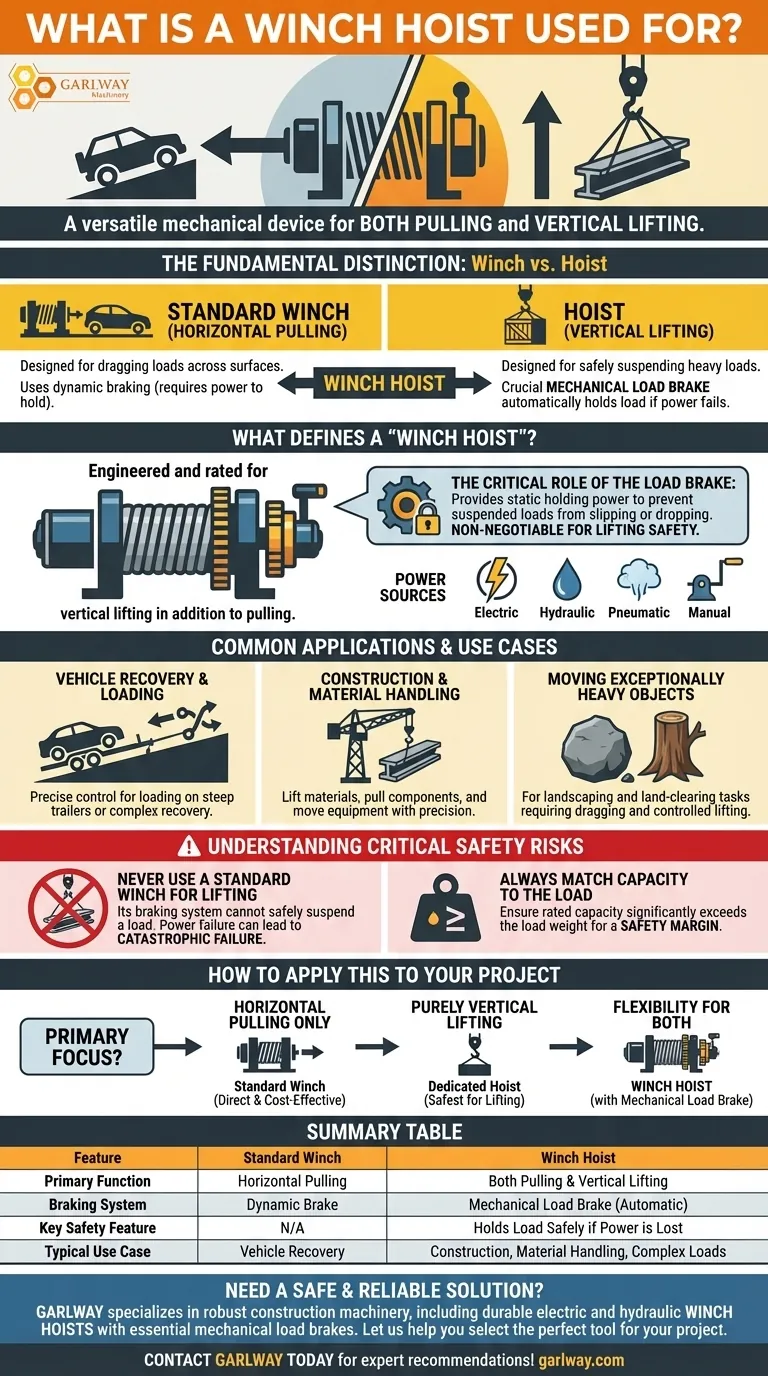In essence, a winch hoist is a specialized mechanical device used for both pulling heavy loads horizontally and, crucially, lifting them vertically. It combines the pulling capability of a standard winch with the load-holding safety features of a hoist, making it a versatile tool for moving objects in multiple directions.
The single most important distinction between a standard winch and a winch hoist is the braking system. A true winch hoist must be equipped with a mechanical load brake that automatically holds a suspended load, making it safe for vertical lifting.

The Fundamental Distinction: Winch vs. Hoist
To understand what a winch hoist is, you must first understand the core purpose of its two parent technologies. The terms are often used incorrectly, which can be dangerous.
How a Standard Winch Works
A standard winch is designed exclusively for horizontal pulling. Its primary function is to drag a load across a surface, such as recovering a stuck vehicle.
Most winches use a dynamic braking system, which requires power to hold the load, or simple clutches. These are not designed to reliably suspend a load in the air.
How a Hoist Works
A hoist is designed exclusively for vertical lifting and lowering. Its entire construction is centered around safely suspending a heavy load.
The critical component is a mechanical load brake. This brake automatically engages the moment lifting stops or power is lost, preventing the load from falling. This is a non-negotiable safety feature for any overhead lifting.
What Defines a "Winch Hoist"?
A winch hoist bridges the gap between these two tools. It is a winch that has been specifically engineered and rated for vertical lifting applications in addition to its pulling function.
The Critical Role of the Load Brake
The feature that qualifies a winch to be used as a hoist is the presence of a load-holding mechanical brake. This is not the same as the dynamic brake found on many off-road winches.
This brake provides the static holding power necessary to prevent a suspended load from slipping or dropping, ensuring the safety of the operation and anyone nearby.
Power Sources and Configurations
Like standard winches and hoists, these devices can be powered by various means to suit different environments and load requirements.
Common power systems include electric, hydraulic, pneumatic (air-powered), and manual (hand-cranked) mechanisms.
Common Applications and Use Cases
The versatility of a winch hoist makes it valuable in a variety of settings where both pulling and lifting are required.
Vehicle Recovery and Loading
While standard winches excel at solo vehicle recovery, a winch hoist offers more control when loading a vehicle onto a steep trailer or performing complex recovery operations that involve some vertical lift.
Construction and Material Handling
In construction, road building, and even mining, electric winch hoists are used to lift materials, pull heavy components into place, and move equipment around a job site with precision and safety.
Moving Exceptionally Heavy Objects
These tools are also used for landscaping and land-clearing tasks, such as repositioning large boulders or moving fallen trees, where both dragging and controlled lifting might be necessary.
Understanding the Critical Safety Risks
Using the wrong tool for an overhead lift is one of the most significant risks in material handling. The distinction between a winch and a winch hoist is not academic—it's a critical safety boundary.
Never Use a Standard Winch for Lifting
Using a pulling-only winch for any vertical lift is exceptionally dangerous. Its braking system is not designed to suspend a load, and a power failure or brake slip can lead to catastrophic failure, causing the load to drop instantly.
Always Match Capacity to the Load
Whether pulling or lifting, ensure the winch hoist's rated capacity significantly exceeds the weight of the object you intend to move. This provides a crucial margin of safety.
How to Apply This to Your Project
Choosing the right equipment is the first step toward a safe and successful operation. Your primary task dictates the correct tool.
- If your primary focus is horizontal pulling: A standard, high-quality winch designed for recovery or pulling is the most direct and cost-effective solution.
- If your primary focus is purely vertical lifting: A dedicated hoist, such as an engine hoist or one integrated into an overhead crane, is the safest and most appropriate tool.
- If you require the flexibility for both pulling and lifting: You must select a device explicitly sold and rated as a "winch hoist" that is confirmed to have a mechanical load brake.
Ultimately, selecting the correct tool is a matter of prioritizing safety and using the equipment precisely as its designers intended.
Summary Table:
| Feature | Standard Winch | Winch Hoist |
|---|---|---|
| Primary Function | Horizontal Pulling | Both Pulling & Vertical Lifting |
| Braking System | Dynamic Brake | Mechanical Load Brake (Automatic) |
| Key Safety Feature | N/A | Holds Load Safely if Power is Lost |
| Typical Use Case | Vehicle Recovery | Construction, Material Handling, Complex Loads |
Need a Safe and Reliable Solution for Your Heavy Lifting and Pulling Tasks?
Choosing the right equipment is critical for safety and efficiency on your job site. GARLWAY specializes in providing robust construction machinery, including durable electric and hydraulic winch hoists designed for the demanding needs of construction companies and contractors globally.
Our winch hoists are engineered with the essential mechanical load brake for safe vertical lifting, combined with powerful pulling capabilities. Let us help you select the perfect tool for your project's unique requirements.
Contact GARLWAY today to discuss your application and get a expert recommendation!
Visual Guide

Related Products
- Electric Hoist Winch Boat Anchor Windlass for Marine Applications
- Heavy Duty Electric Boat Winch Windlass Anchor
- Warn Winch Windlass Boat Trailer Winch
- Electric and Hydraulic Winch for Heavy Duty Applications
- Best 18000 Pound Drum Anchor Trailer Winch
People Also Ask
- What are the advantages of an electrically operated trailer winch? Enhance Safety & Control for Your Trailer
- How do electric hoists help prevent workplace injuries? Engineer a Safer, More Efficient Workspace
- What adjustments are necessary for the hoist winch's main controller? Achieve Sub-1 cm Lifting Precision
- How should the hoist winch be debugged after installation? A 3-Phase Guide to Ensure Safety & Reliability
- What are the benefits of consistent lifting power in electric hoists? Boost Productivity & Safety










